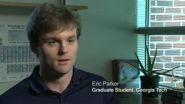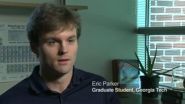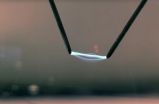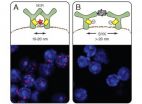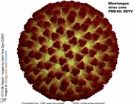(Press-News.org) VIDEO:
Graduate student and study first author Eric Parker talks about the famous spark discharge experiment and the latest findings from a first-ever analysis of Miller's samples from 1958.
Click here for more information.
Stanley Miller, the chemist whose landmark experiment published in 1953 showed how some of the molecules of life could have formed on a young Earth, left behind boxes of experimental samples that he never analyzed. The first-ever analysis of some of Miller's old samples has revealed another way that important molecules could have formed on early Earth.
The study discovered a path from simple to complex compounds amid Earth's prebiotic soup. More than 4 billion years ago, amino acids could have been attached together, forming peptides. These peptides ultimately may have led to the proteins and enzymes necessary for life's biochemistry, as we know it.
In the new study, scientists analyzed samples from an experiment Miller performed in 1958. To the reaction flask, Miller added a chemical that at the time wasn't widely thought to have been available on early Earth. The reaction had successfully formed peptides, the new study found. The new study also successfully replicated the experiment and explained why the reaction works.
"It was clear that the results from this old experiment weren't some sort of artifact. They were real," said Jeffrey Bada, distinguished professor of marine chemistry at the Scripps Institution of Oceanography at the UC San Diego. Bada was a former student and colleague of Miller's.
The study was supported by the Center for Chemical Evolution at the Georgia Institute of Technology, which is jointly supported by the National Science Foundation and the NASA Astrobiology Program. The study was published online June 25 in the journal Angewandte Chemie International Edition. The work was primarily a collaboration between UC San Diego and the Georgia Institute of Technology in Atlanta. Eric Parker, the study's lead author, was an undergraduate student in Bada's laboratory and is now a graduate student at Georgia Tech.
Jeffrey Bada was Stanley Miller's second graduate student. The two were close and collaborated throughout Miller's career. After Miller suffered a severe stroke in 1999, Bada inherited boxes of experimental samples from Miller's lab. While sorting through the boxes, Bada saw "electric discharge sample" in Miller's handwriting on the outside of one box.
"I opened it up and inside were all these other little boxes," Bada said. "I started looking at them, and realized they were from all his original experiments; the ones he did in 1953 that he wrote the famous paper in Science on, plus a whole assortment of others related to that. It's something that should rightfully end up in the Smithsonian."
The boxes of unanalyzed samples had been preserved and carefully marked, down to the page number where the experiment was described in Miller's laboratory notebooks. The researchers verified that the contents of the box of samples were from an electric discharge experiment conducted with cyanamide in 1958 when Miller was at the Department of Biochemistry at the College of Physicians and Surgeons, Columbia University.
An electric discharge experiment simulates early Earth conditions using relatively simple starting materials. The reaction is ignited by a spark, simulating lightning, which was likely very common on the early Earth.
The 1958 reaction samples were analyzed by Parker and his current mentor, Facundo M. Fernández, a professor in the School of Chemistry and Biochemistry at Georgia Tech. They conducted liquid chromatography- and mass spectrometry-based analyses and found that the reaction samples from 1958 contained peptides. Scientists from NASA's Johnson Space Center and Goddard Space Flight Center were also involved in the analysis.
The research team then set out to replicate the experiment. Parker designed a way to do the experiment using modern equipment and confirmed that the reaction created peptides.
"What we found were some of the same products of polymerization that we found in the original samples," Parker said. "This corroborated the data that we collected from analyzing the original samples."
In the experiment from 1958, Stanley Miller had the idea to use the organic compound cyanamide in the reaction. Scientists had previously thought that the reaction with cyanamide would work only in acidic conditions, which likely wasn't widely available on early Earth. The new study showed that reactive intermediates produced during the synthesis of amino acids enhanced peptide formation under the basic conditions associated with the spark discharge experiment.
"What we've done is shown that you don't need acid conditions; you just need to have the intermediates involved in amino acid synthesis there, which is very reasonable," Bada said.
Why Miller added cyanamide to the reaction will probably never be known. Bada can only speculate. In 1958, Miller was at Columbia University in New York City. Researchers at both Columbia and the close-by Rockefeller Institute were at the center of studies on how to analyze and make peptides and proteins in the lab, which had been demonstrated for the first time in 1953 (the same year that Miller published his famous origin of life paper). Perhaps while having coffee with colleagues someone suggested that cyanamide – a chemical used in the production of pharmaceuticals – might have been available on the early Earth and might help make peptides if added to Miller's reaction.
"Everybody who would have been there and could verify this is gone, so we're just left to scratch our heads and say 'how'd he get this idea before anyone else,'" Bada said.
The latest study is part of an ongoing analysis of Stanley Miller's old experiments. In 2008, the research team found samples from 1953 that showed a much more efficient synthesis than Stanley published in Science in 1953. In 2011, the researchers analyzed a 1958 experiment that used hydrogen sulfide as a gas in the electric discharge experiment. The reactions produced a more diverse array of amino acids that had been synthesized in Miller's famous 1953 study. Eric Parker was the lead author on the 2011 study.
"It's been an amazing opportunity to work with a piece of scientific history," Parker said.
INFORMATION:
This research is supported by the Center for Chemical Evolution at the Georgia Institute of Technology, which is jointly supported by the National Science Foundation and the NASA Astrobiology Program under award number NSF CHE-1004570. Any conclusions or opinions are those of the authors and do not necessarily represent the official views of the sponsoring agencies.
CITATION: Eric T. Parker, et al., "A Plausible Simultaneous Synthesis of Amino Acids and Simple Peptides on the Primordial Earth." (Angewandte Chemie, June 2014). http://dx.doi.org/10.1002/anie.201403683
Stanley Miller's forgotten experiments, analyzed
2014-06-25
ELSE PRESS RELEASES FROM THIS DATE:
Restoring thyroid hormones in heart may prevent heart disease from diabetes
2014-06-25
Old Westbury, N.Y. (June 25, 2014) –Administering low doses of a thyroid hormone to rats with diabetes helps restore hormone levels in their hearts and prevented deterioration of heart function and pathology, according to a new study by NYIT College of Osteopathic Medicine professor A. Martin Gerdes.
The study, published in the online edition of Molecular Medicine provides the first clear indication that low thyroid hormone levels in cardiac tissue of diabetic individuals may be the major cause of their associated heart disease, says Gerdes.
The study finds that diabetes ...
Neural sweet talk: Taste metaphors emotionally engage the brain
2014-06-25
So accustomed are we to metaphors related to taste that when we hear a kind smile described as "sweet," or a resentful comment as "bitter," we most likely don't even think of those words as metaphors. But while it may seem to our ears that "sweet" by any other name means the same thing, new research shows that taste-related words actually engage the emotional centers of the brain more than literal words with the same meaning.
Researchers from Princeton University and the Free University of Berlin report in the Journal of Cognitive Neuroscience the first study to experimentally ...
Special edition of the Red Journal highlights the need for radiation oncology services in LMICs
2014-06-25
Fairfax, Va., June 25, 2014—The July 1, 2014 edition of the International Journal of Radiation Oncology ● Biology ● Physics (Red Journal), the official scientific journal of the American Society for Radiation Oncology (ASTRO), features a special section of 10 articles focusing on global health and radiation oncology in low- and middle-income countries (LMICs.)
Three papers examine the overall need for more and the current opportunities to provide radiation oncology in LMICs, C. Norman Coleman, MD, FASTRO, highlights the work and the four main principles of ...
Study highlights carbon monoxide hazards on houseboats
2014-06-25
FALLS CHURCH, Va. (June 25, 2014) — Boaters and marina workers should exercise caution this summer before taking to the seas. A study published online in the Journal of Occupational and Environmental Hygiene (JOEH) outlines hazards posed by carbon monoxide levels on houseboats that use gasoline-powered generators without emission controls, along with controls that are available to reduce exposure to carbon monoxide from the generators.
The study, conducted by researchers at the National Institute for Occupational Safety and Health (NIOSH), found that uncontrolled generators ...
New treatment option in development for individuals with food allergy
2014-06-25
New Rochelle, NY, June 25, 2014—For some children an allergic reaction to common foods such as milk, eggs, or peanuts can cause an anaphylactic reaction. At present no effective treatment for food allergy exists, and strict dietary avoidance of known food triggers is the only preventive option available. Ongoing trials are exploring options for oral immunotherapy (OIT) for desensitization in the treatment of Immunoglobulin E (IgE)-mediated food allergy, as described in a Review article in Pediatric Allergy, Immunology, and Pulmonology, a peer-reviewed journal from Mary ...
Deploying midwives in poorest nations could avert millions of maternal and newborn deaths
2014-06-25
A modest increase in the number of skilled midwives in the world's poorest nations could save the lives of a substantial number of women and their babies, according to new analyses by researchers from the Johns Hopkins Bloomberg School of Public Health.
Maternal mortality is a leading cause of death for women in many developing countries and public health efforts to avert it have only made headway in a few countries. Elsewhere, progress has either never started or has stalled in recent years. Poor nations also have troubling rates of infant and fetal deaths. Midwives ...
Mathematical models explain how a wrinkle becomes a crease
2014-06-25
PROVIDENCE, R.I. [Brown University] — Wrinkles, creases and folds are everywhere in nature, from the surface of human skin to the buckled crust of the Earth. They can also be useful structures for engineers. Wrinkles in thin films, for example, can help make durable circuit boards for flexible electronics.
A new mathematical model developed by researchers from Brown University could help engineers control the formation of wrinkle, crease, and fold structures in a wide variety of materials. It may also help scientists understand how these structures form in nature. The ...
Nanoscale ruler reveals organization of the cell membrane
2014-06-25
This news release is available in German.
After a ten-year effort, Prof. Dr. Michael Reth from the Institute of Biology III of the University of Freiburg and the Max Planck Institute of Immunobiology and Epigenetics has developed a method to investigate the cell surface's organization on a nanometer scale. This allows him to monitor how the antigen receptor, which B cells of the immune system use to recognize foreign substances, changes after activation. This study shows that the receptor components dissociate from each other– rather than assemble, as previously ...
New study quantifies the effects of climate change in Europe
2014-06-25
If no further action is taken and global temperature increases by 3.5°C, climate damages in the EU could amount to at least €190 billion, a net welfare loss of 1.8% of its current GDP. Several weather-related extremes could roughly double their average frequency. As a consequence, heat-related deaths could reach about 200 000, the cost of river flood damages could exceed €10 billion and 8000 km2 of forest could burn in southern Europe. The number of people affected by droughts could increase by a factor of seven and coastal damage, due to sea-level rise, could more than ...
Using math to analyze movement of cells, organisms, and disease
2014-06-25
Traveling waves model tumor invasion
Cell migration, which is involved in wound healing, cancer and tumor growth, and embryonic growth and development, has been a topic of interest to mathematicians and biologists for decades.
In a paper published recently in the SIAM Journal on Applied Dynamical Systems, authors Kristen Harley, Peter van Heijster, Robert Marangell, Graeme Pettet, and Martin Wechselberger study a model describing cell invasion through directional outgrowth or movement in the context of malignant tumors, in particular, melanoma or skin cancer. Tumor ...
